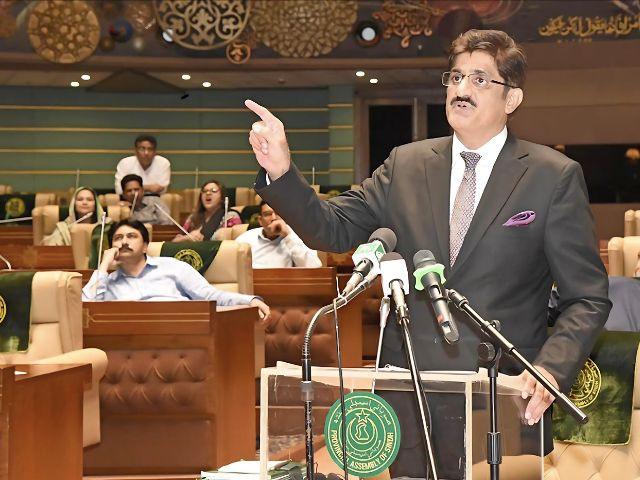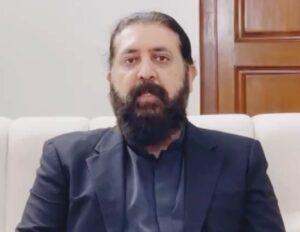Sindh-chief Minister Syed Murad Ali Shah, presented the provincial budgetary estimates for the year 2025-2026 in the Assembly amounting to Rs. 3,451.87 billion, with a deficit of Rs. 38.458 billion dollars of an increase of $ 12.9% compared to budgetary estimates of the previous year of RS. billions for the year 2024-25.
The chief minister announced a salary increase of 12% for employees of the BS-1s to BS-16 classes and an increase of 10% for those of the BS-17 classes to BS-22, as well as an 8% increase in pensions.
“We are presenting a financial bill to abolish and reduce certain taxes / levies / cess instead of increasing them,” said the chief minister.
Key characteristics of the Sindh budget
• 5 samples: professional tax, entertainment rights, drainage cess, cotton fees and local abolished cess
• Reduction of taxes on motor vehicles, simplification of the sales tax, including passing through a negative list system.
• Proposed from 12 to 10% ad hoc allowance for government employees and an increase of 8% of pension.
• Improvement of the transport allowance for employees with differently capacity and authorization of unanswered retirement contributions.
• Rs. 146.9 billion were reserved as subsidies for health units and institutions.
• Rs. 523.73 billion dollars allocated to the education sector, up 12.4% percent of the outgoing year
The budget highlights increased allowances for education, health, infrastructure and social protection, as well as strategic initiatives to modernize governance and stimulate economic growth.
Budget 2025-26
The province’s receipts for the year 2025-26 are projected at Rs. 3,411.5 billion, marking an increase of 11.6% compared to the current year.
Federal divisible pool transfers, which represent 75% of total income, are estimated at Rs. 1,927.3 billion, an increase of 10.2%, despite a deficit of 5.5% in the revised estimates of the current year.
Additional federal transfers, including right transfers and subsidies to compensate for the losses of the abolition of the OZT, should also increase, which has increased the total of federal transfers to Rs. 2,095.6 billion.
Current income expenses (CRE) set at Rs. 2,149.4 billion, reflecting an increase of 12.4% compared to Rs. 1,912.36 billion in the year 2024-25.
This increase is due to inflationary pressures, an increase in subsidies to non -financial institutions such as hospitals and universities, employee allowances for government and higher retirement payments.
Sectoral expenses and allowances
Total expenses are expected to increase by 12.9% to Rs. 3,450 billion. Current income expenses will increase by 12.4%to Rs. 2,150 billion, driven by wages and pension increases (6%), subsidies to local organizations (3%) and substantial increases in the key sectors:
• Police department: Rs. 189.75 billion (increase of 15.7%)
• Health sector: Rs. 336.46 billion (increase of 11.3%)
• – Education sector: Rs. 518.05 billion (18%increase)
In addition, Rs. 20 billion were allocated to “social protection and economic sustainability initiatives”, highlighting the accent put by the government on inclusive growth. To improve transparency and efficiency, education funds will be directly disbursed in schools.
Subsidies in the total of Rs. 702 billion were allocated to various government and non -financial institutions, based on the directives of the Secretariat of the Minister of Chief and the Department of Finance.
Education sector
The education sector received an allocation from Rs. 523.73 billion, which represents an increase of 12.4% compared to Rs. 458.2 billion last year, representing 25.3% of the total of the CRE.
Significant increases are observed at all levels: the primary education budget increased from Rs. 136.2 billion to Rs. 156.2 billion, while the secondary education budget went from Rs. 68.5 billion to Rs. 77.2 billion.
New initiatives include hiring 4,400 staff members, the creation of four IBA community colleges and the empowerment of more than 34,100 primary schools with dedicated cost centers and budgets. Rs. 2 billion were allocated to the Sindh Education Endowment Fund to support meritorious and disadvantaged students.
The budget for the Development Program of Persons (DEPD) of people with differently went from Rs. 11.6 billion to Rs. 17.3 billion, providing improved support for devices, allowances and assistance partnerships with NGOs.
Health sector
The health budget is set at Rs. 326.5 billion, which represents an increase of 8% compared to the RS allocation last year. 302.2 billion.
From this amount, Rs. 146.9 billion are designated as subsidies in health units and institutions.
Key allowances include Rs. 19 billion for the Sindh Institute of Urology & Transplantation (SIUT), Rs. 16.5 billion for people Primary Health Initiative (PPHI) and RS. 10 billion for a new hospital in Larkana. In addition, there will be an expansion of ambulance services and mobile diagnostic units to improve access to health care in rural areas.
The development portfolio and the annual development program (ADP) were rationalized to Rs. 520 billion, following a reduction of 20% due to the expected federal transfer deficits. The emphasis will be placed on 475 new plans which prioritize the rehabilitation of floods, renewable energies, development in underdeveloped districts, drinking water and sanitation services.
The main benefits in the sector include 99.6 billion for education, 45.37 billion for health, rs. 73.9 billion for irrigation, and Rs. 132 billion for the local government.
Karachi development
Significant improvements in infrastructure is planned for Karachi, including the rehabilitation of roads and improvements in the supply of sewers and water in several districts.
Urban transport in Karachi will develop with the introduction of the first 50 electric buses of Pakistan, with plans to add 100 others by August 2025.
The progress of rapid bus transport projects (BRT) of the city include the yellow line during completion and the red line being complete at 50%.
Karachi Safe City:
The Karachi Safe City project makes progress with the implementation of video surveillance systems integrated into AI and extended coverage. Progress is also made on major projects such as the Korangi Causeway bridge and improvements to Shahrah-E-Bhutto.
The new ADP initiatives will aim for the restoration of heritage, will improve the activity zones and facilitate the constructions of crucial roads.
Digital governance
The launch of a centralized key performance monitoring board (KPI) will allow project to monitor real time. The reform of land records based on the blockchain aims to simplify real estate transactions and improve transparency. In addition, a digital birth registration system aims at 100% coverage by 2028, integrating health and education data.
Agricultural reforms
The introduction of the Benazir Hari card will support more than 200,000 farmers with subsidies and mechanization aid. Intelligent climate agriculture will be promoted by subsidy subsidies and cluster agriculture projects focused on public-private partnership.
A feasibility study is currently underway for the Sindh Cooperative Bank in order to offer loans without interest to progressive farmers.
Social protection and empowerment:
The decentralization of education budgets will allow heads of schools to operational fund schools. Support for people with disabilities will develop, including an increase in allowances and the creation of new rehabilitation centers. In addition, youth development centers will be implemented in the Sindh, providing skills training, career advice and digital literacy programs.
Tax and relief measures
The abolition of five samples, including professional tax and entertainment rights, aims to relieve financial charges. There will also be tax reductions on motor vehicles and a simplification of the sales tax thanks to a transition to a negative list system.
The chief minister announced an ad hoc rescue allowance of 12% for government employees in BPS-16 in BPS-16, and an increase of 10% for those from BPS-19 to BPS-22, as well as an 8% increase in pensions.
An improved transfer allowance for employees with differently capacity will be introduced and all the outstanding retirement contributions will be eliminated. Special subsidies for lawyers, journalists and minority groups will support initiatives for well-being and development.
Murad Ali Shah highlighted the role of the budget in exploiting Sindh’s unexploited potential through inclusive, resilient and sustainable development.
He called for unity and collective efforts to guide the province and the nation towards peace, progress and prosperity. This complete budget reflects Sindh’s commitment to social uprising, the modernization of infrastructure and economic empowerment, positioning the province for an upcoming transformative year.




